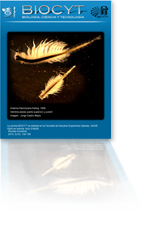Potencial reproductivo de seis poblaciones mexicanas de Artemia franciscana Kellog, 1906 cultivadas en laboratorio a 100 y 120 UPS
Main Article Content
Abstract
This study compared the reproductive potential of six Mexican A. franciscana strains from Pacific and Yucatan Peninsula coast waters and inland waters from Mexico. Each strain was cultivated in 200 l beakers in 100 and 120 of UPS. Temperature was controlled at 25 ± 2 °C, continuous light and aeration, and pH 8-10. The organisms were fed ad libitum with 50 ml of rice bran and Tetraselmis sp. microalgae. Reached sexual maturity, one female and two males of each strain were separated in 25 beakers of 250 ml to obtain reproductive characteristics values. After two months of Artemia culture, total biomass and cysts were weight. All reproductive characteristics values increased at 120 UPS. All strains did not shown significant differences (Tukey p<0.05) in number of broods, nauplii produced and life span duration in contrast with cysts production. The populations with better biomass production were RSAL y JUCH and cysts JUCH y OHUI. This information at laboratory conditions, can be allows the biological basins for semi intensive culture systems in their natural habitat.
